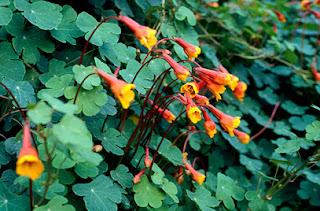Why native plants?
Suburban sprawl and development has led to the fragmentation and disappearance of native flora and natural habitat for both plants and animals. The crisis in the honeybee population has brought attention to the disappearance of pollinators of other sorts as well. Many native insects depend on specific native plants for their food source and the disappearance of those native plants leads to the disappearance of those insects. In turn, these insects are often the primary food fed to baby birds, so a decrease in insect population results in a decrease in the bird population. We generally see insect-eaten plants as a bad thing but it is a natural part of the food web and we need to appreciate the role of native plants and insects in the grand scheme of life.Native Plant Societies
Helpful Websites
The Audubon Society at Beechwood Farms in the North Hills offers native plants for sale and has a list of native plants with descriptions.
The Penn State Extension has provided a list of native plants without photos.
The Pennsylvania Department of Conservation and Natural Resources tells you why to landscape with native plants and what to look for. The site includes a searchable native plant database.
Commercially available native plant species suitable for planned landscapes in Pennsylvania. These include a photo.
Bibliography
All of the following books can be obtained from the public libraries in Allegheny County. Just do a title search in the eiNetwork online catalog: https://librarycatalog.einetwork.net/
Subject Search: Native Plant Cultivation
Armitage's Native Plants for North American Gardens
By A. M. Armitage; Timber Press 2006
Armitage provides an alphabetical guide by scientific name to native plants of North America that make good garden plants.
Attracting Beneficial Bugs to Your Garden: A Natural Approach to Pest Control By Jessica Walliser; Timber Press
Jessica Walliser cohosts the Organic Gardener radio show on KDKA with Doug Oster.
Attracting Native Pollinators, Protecting North America's Bees and Butterflies
By The Xerces Society; Storey Publishing 2011
The Xerces Society is a nonprofit that works to save invertebrates (including insects) and their habitats. Check out their other publications.
Bringing Nature Home
By Doug Tallamy; Timber Press
Tallamy contends that because man has left so few natural areas in the U.S., people have to make their home gardens into habitats that can support wildlife.
Garden Revolution: How Our Landscapes Can Be a Source of Environmental ChangeBy A. M. Armitage; Timber Press 2006
Armitage provides an alphabetical guide by scientific name to native plants of North America that make good garden plants.
Attracting Beneficial Bugs to Your Garden: A Natural Approach to Pest Control By Jessica Walliser; Timber Press
Jessica Walliser cohosts the Organic Gardener radio show on KDKA with Doug Oster.
Attracting Native Pollinators, Protecting North America's Bees and Butterflies
By The Xerces Society; Storey Publishing 2011
The Xerces Society is a nonprofit that works to save invertebrates (including insects) and their habitats. Check out their other publications.
Bringing Nature Home
By Doug Tallamy; Timber Press
Tallamy contends that because man has left so few natural areas in the U.S., people have to make their home gardens into habitats that can support wildlife.
By Larry Weaner and Thomas Christopher; Timber Press
"Garden Revolution shows how an ecological approach to planting can lead to beautiful gardens that buck much of conventional gardening’s counter-productive, time-consuming practices. Instead of picking the wrong plant and then constantly tilling, weeding, irrigating, and fertilizing, Weaner advocates for choosing plants that are adapted to the soil and climate of a specific site and letting them naturally evolve over time."
The Living Landscape: Designing for Beauty and Biodiversity in the Home Garden
By Rick Darke and Doug Tallamy; Timber Press
Darke and Tallamy show how you can make a diverse layered landscape: "one that offers beauty on many levels, provides outdoor rooms and turf areas for children and pets, incorporates fragrance and edible plants, and provides cover, shelter, and sustenance for wildlife."
Native Plants of the Northeast, a guide for gardening and conservation
By Donald J. Leopold; Timber Press 2005
Entries for nearly 700 species of native trees, shrubs, vines, ferns, grasses, and wildflowers from the northeastern quarter of the U.S. and eastern Canada.
Planting in a Post-Wild World
By Thomas Rainer and Claudia West; Timber Press 2015
Rainer and West advocate gardening to bring nature back to cities and gardens by replicating nature’s style: robust and diverse.
Easy-to-Grow Native Plants
These are plants that have grown successfully in my Monroeville garden.
Perennials
Sun
Baptisia, False indigo
Baptisia, False indigo
Butterfly weed (rather difficult to get established) Asclepias tuberosa
Canadian Columbine, Aquilegia canadensis (reseeds itself)
Canadian Windflower, Anemone canadensis
Common Milkweed, Asclepias syriaca (spreads aggressively by rhizomes)Goldenrod, Solidago rugosa 'Fireworks' (This cultivar clumps instead of invading with rhizomes.)
Monarda didyma (common beebalm)
Obedient Plant, Physostegia virginiana
Purple Coneflower, Echinacea purpurea (the common variety reseeds itself)
Swamp milkweed, Asclepias incarnata (spreads by seeds)
Wild Senna or partridge tree, Senna hebecarpa (flowers covered with bees)
Shade
Allegheny Foamflower, Tiarella cordifolia
Bloodroot, Sanguinaria canadensis
Mayapple, Podophyllum peltatum (once established they spread aggressively)
Northern maidenhair fern, Adiantum pedatum
Wild Ginger, Asarum canadense
Wood poppy or Celandine Poppy, Stylophorum diphyllum (reseeds all over)
Shrubs and Trees
Fringe Tree, Chionanthus virginicus (fragrant flowers)
Ninebark, Physocarpus opulifolius
Serviceberry, Amelanchier arborea
Winterberry, Ilex verticillata (male & female plants required for berries)






















